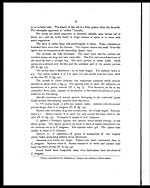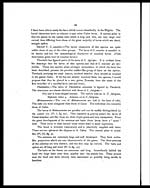Medicine - Institutions > Army health reports and medical documents > Scientific memoirs by officers of the Medical and Sanitary Departments of the Government of India > Number 25 - On the importance of larval characters in the classification of mosquitoes > On the importance of larval characters in the classification of mosquitoes
(17) Page 9
Download files
Individual page:
Thumbnail gallery: Grid view | List view

9
GROUP III. Adult mosquitoes showing scale arrangement typical of the
genus Culex, but having larval characters recalling those of Stegomyia. Four
species, all unfortunately undetermined, were noted. All the forms were found
in natural pools.
Species a.—Nymph trumpets, opening wide, somewhat resembling those of
Stegomyia.
Head rather broad, antennæ like those of Stegomyia, but larger and having
a few small spines. Basal tufts small and composed of a few hairs. Median
and terminal spines abortive (Pl. II, fig. 7). Mental plate resembles that
of S. sugens (Pl. III, fig. 2). Siphon tube large (Pl. II, fig. 19), 18 of
body length. Siphonic index 1.9. Sixteen spines in each row shaped as in
Stegomyia.
Species b.—Nymph trumpet rather broad, but narrower than above. More
truncated than in species a. Antenna resembles that of Stegomyia (Pl. II,
fig. 8). Basal tuft small. Two rather large median spines present. No ter-
minal spines. The antennæ are covered with a few short spines.
Siphon tube large, .2 of body length. Siphonic index 2.7. Eighteen spines
in each row.
Species c.—Trumpets of nymph nearly truncated, but opening slightly
obliquely (Pl. I, fig. 16).
Larva long. Rests in nearly vertical position (Pl. III, fig. 26). Head
very small and like that of Stegomyia. Antennæ comparatively small. Basal
tuft short, but composed of many hairs. Median and terminal spines small and
inconspicuous. Antenna covered with large and prominent spines (Pl. II,
fig. 9).
Siphon tube enormous and very massive, .26 of body length. Siphonic
index 5.9. Nineteen spines in each row. Whole tube strongly chitinised and
opaque (Pl. II, fig. 21).
Species d.—Trumpets of nymph resembling those of species c.
Larva long (Pl. I, fig. 22). Rests in nearly vertical position (Pl. III,
fig. 26). Head small and shaped much as in Stegomyia. Antennæ long and
well developed. Basal tuft short but composed of many hairs. Median spines
fairly well developed. Third portion of antenna readily seen. Terminal portions
short and inconspicuous. The whole antenna is densely covered with long
spines (Pl. II, fig. 10). Siphon tube enormous, not so massive as that of species c,
but very similar in its horn-like appearance, .28 of body of length. Siphonic
index 7.5 (Pl. II, fig. 22).
These larval characters certainly suggest that the group concerned have
little in common with the Culex fatigans group.
GROUP IV. Culex mimeticus.—Theobald figures the siphon tube and
C
Set display mode to: Large image | Zoom image | Transcription
Images and transcriptions on this page, including medium image downloads, may be used under the Creative Commons Attribution 4.0 International Licence unless otherwise stated. ![]()
| Permanent URL | https://digital.nls.uk/75029033 |
|---|
| Shelfmark | IP/QB.10 |
|---|---|
| Additional NLS resources: | |




